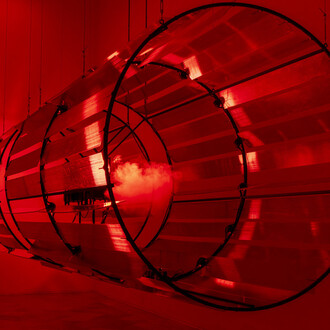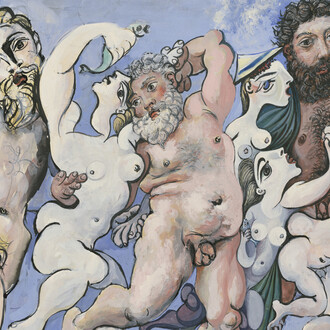Absolute color does not exist. It is always a relationship. A relationship between the object and the observer; between the object and the direction of the rays that illuminate it; between the material of which the object is made and the humidity of the air.
Antonioni corresponded with Rothko, and when they spoke, their conversations were about colors and light. Nothing more than that. It was something like a walk through sensations. But Antonioni understood, like few others did, that what Rothko was achieving was a transformation in the very essence of abstract painting, by allowing the emotional power of color to surpass the gestural act. Antonioni also sought this through his films: to create a complete sensory experience between the image and the viewer, or between the image and the one who lives it or moves through it. In painting, we could apply this principle to many artists: from Clyfford Still to Barnett Newman, or from Morandi to Helmut Federle, or from Agnes Martin to Sean Scully and his weathered whites. Deleuze managed to define it in a very visual way: it’s about painting the sensation, that which resonates in memory and tries to surface, eventually emerging from within the painting itself. For Antonioni, color is a relationship between the object and the psychological state of the viewer, and to him, the two mutually influence and suggest one another.
That universe distilled by Antonioni in his films and in his small photographs of enchanted mountains was the first thing that came to mind when I saw Alba Suau’s painting. In her work, forms rest while they throb and reach out toward us, something like a memory that hides and folds in on itself, only to later expand in tactile marks and nuances, stripped of anything accidental. The painting creates a world of its own, which settles into an inner landscape where the indelible rises to the surface, and the sign dissolves into a fluid, magmatic, and enigmatic form. With uncertain yet precise contours, her chromatic fields take hold of the canvas without stridency, giving shape to a transitive silence where the extraordinary act of plunging into a moment echoes, without pause. This is why she insists in the places, so the image can resonate once more. Memory dissolves the image, and the artist recovers it, again and again, through the same gestures, proving that what appears random is, in fact, orchestrated by an obsession with making everything rhyme. Because these are not strictly abstract formless paintings; the color organizes the space, leaving the landscape ajar, but there is always a landscape, a prior gaze, a sense of reality.
We notice it in the titles that, unlike in other moments of her career, she now dares to add to her paintings: Donde la serpiente; Mesa montosa; Cañón del Chama; Dos arroyos…; etc. The title for this exhibition itself refers to the geological formations and washed-out color of Plaza Blanca. Physical memory intervenes in the pictorial process, which is why the artist herself may come to feel that she now works without a score, even though everything is a distillation of what has been learned, a synthetic will that softens the initial image and reframes it within the margins of the canvas, because there is always a broader space being evoked than the one we can fully grasp with our gaze. Because, indeed, what we see in these paintings is an interstitial space, where emptiness and saturation are impossible to discern because they are in dialogue. If Maurice Blanchot said, in reference to Giacometti, that he sculpted distance, we might think that what is painted here is precisely that, a shifting and rigid distance, one that plunges inward. It’s about finding the right tuning, much like when Peter Zumthor brings architecture close to the idea of “tuning pianos”. Alba Suau’s position is deeply physical, but also highly analytical. It’s about summoning the memory of forms, but also about entering into the very matter of painting, as if trying to call forth the image of a murmur.
Something similar happens in Red desert by Antonioni, where colors shift very slowly; they learn to linger. The same sensation is evoked by the paintings of Alba Suau, in which color becomes a kind of memory perspective, a distillation of thick, unfathomable immensity. Reality is merely the starting point for a parallel reality, where the image is never fully revealed. It is the gaze that unfolds its own time, because her paintings always demand a second look and the act of perception becomes an endless experience.
I confess I’ve always been drawn to artists who insist on the repetition of a form, an image, or a light in order to summon the resonance of the gaze, as if they were trying to hide depth within the surface. These paintings do, indeed, explore what is latent, though no event more extraordinary occurs than the stillness of illuminated nature. Hence the importance of slowness, something understood by artists such as Vermeer, Cézanne, or Rothko, but also by filmmakers like the aforementioned Antonioni, and writers such as Peter Handke or John Berger. In all of them we can find what Carlos Martí Arís defined as “eloquent silences,” a way of describing creators who have made restraint a fundamental condition of their work, from Borges’s invitation to lose oneself in the intricate paths of his labyrinth, to how silence in Yasujiro Ozu’s cinema becomes both sonorous and meaningful, allowing us to contemplate a part of the world on the verge of vanishing. For Borges, every place is archaeological, and if we dig into its history, we always uncover something of what came before it. Alba Suau’s painting also rests within that suspended, blurred time, yet capable of carrying both a story and a landscape. The key lies in moving patiently and attentively across different scales, and in fully drawing out the poetics of the image as observation, much like in Tarkovsky’s cinema.
In Alba Suau’s working process, it is walking that reveals the place that later becomes painting. In this case, New Mexico and its landscapes are the object of that memory, that atmospheric experience, that act of being there. Reality is always in motion, out of focus. It is her way of undoing the image, of turning it abstract. Mystery is reinforced through that density; physical tension is pushed to the limit and embraces blurriness. In these recent works, we can see how her practice has evolved; in some, drawing becomes more apparent; in others, it seems she is playing with raw canvas, even though it is never just the bare support, as it is always stained, however lightly. Emptiness is conceived as matter, as an active background. It is her way of undoing the image, of breaking it apart. Mystery is enveloped and reinforced by that density. Physical tension is carried to the edge, and the blurriness of color is embraced. These are places that carry within them the sense of loss evoked by Georges Didi-Huberman when he writes that “the modality of the visible becomes ineluctable — that is, bound to a question of being — when seeing means feeling that something inevitably escapes us: in other words, when seeing is losing”. Alba Suau’s painting reminds us that the spirit of a place is always an ephemeral, experiential quality and, as Juhani Pallasmaa notes, an unfocused one.
In this sense, How to do nothing by Jenny Odell, a book that has influenced Alba Suau’s sensibility, speaks about the difficulty of sustaining attention on any one thing. She cites William James, who understood that there is no such thing as continuous attention; all we do is bring it back again and again. It is likely for this reason that Alba Suau insists on places and also on why she looks at her own paintings over and over again in the studio, trying to grasp that spatial experience that arises from walking, with the intention that those sensations might forever float in our minds, in this case, in the form of painting. As in The walk by Robert Walser, it is about searching for new things while retracing the same mental paths again and again, with a curious, patient gaze.
(Text by David Barro López)






![Saul Steinberg, The museum [El museo] (detalle), 1972. Cortesía del Museo de Arte Abstracto Español](http://media.meer.com/attachments/dfbad16c22c5940b5ce7463468ac8879f3b4bf23/store/fill/330/330/042ecf3bcd2c9b4db7ddbc57cb32e950c095835f7b5cd55b6e1576a6e78c/Saul-Steinberg-The-museum-El-museo-detalle-1972-Cortesia-del-Museo-de-Arte-Abstracto-Espanol.jpg)


